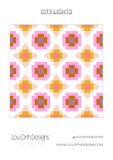Why you need a Tailor's clapper
The links in this blog post are affiliate links. If you click an affiliate link and make a purchase I receive a small commission.
Hello, so today I am here to tell you all about the tailor’s clapper. I’m going to be talking about what it is, how to use it (and why you need one.)

Let’s jump straight in, first up, what is a tailor’s clapper?
A tailor’s clapper is essentially a rectangular block of wood that you lay on top of a seam after pressing to get a crisp and flat seam. So, if you like to have flat seams when you sew (I know I do) then this humble tool can help you!
They are made from hardwood, (such as Cherry, Maple and Walnut) as they need to be heavy and close grained to work their magic.
Here's mine:
How does it work?
The wood absorbs the steam and holds the heat into the seam as it cools, leaving the seam flatter and neater.
The tailor’s clapper is probably going to be one of the most low tech tools in your kit. To use it, first press your seam as you normally would, using a steam or by misting the seam with some water beforehand. Then as you take the iron off, lay the clapper down immediately on top of the seam and leave for 5- 10 seconds or until cool. You don’t need to press on it or do anything fancy.
You can also use it to help flatten out creases in the fabric.
Here is a sample I've made up for you. The front is using the clapper and the back is simply pressed.

This is great for quilters, as flat seams lead to neater blocks and also make the job easier when it comes to basting and quilting. I love anything that makes basting easier.
It is also good for garment making and also other accessories sewing, a flat seam will make a top stitch neater and easier to sew.
It's easier to see the difference with a couple of extra seams. The one at the front has been pressed and at the back a tailor's clapper has also been used.

Okay, I think I need one, what do I look for?
Here’s a few things to consider when buying your clapper:
Size. They can come in a range of sizes. Think about you needs and what size would suit you best. The one I have is 12” long as I was happy that that size would cover most seams in most blocks.
Wood type. Make sure the wood is a close grain hard wood like Cherry, Maple, Walnut etc.
Finish. They shouldn’t have any varnish or oils on them, just smoothed out wood. Not only could an oil or varnish transfer to the fabric but it could also stop the wood doing its job properly.
The one I have (as seen in the pics) is a handmade walnut clapper that I found on Etsy
Check out your local quilt/sewing shop and see if they stock one or check out the many different handmade versions on Etsy.
I hope you enjoyed finding out a little more about the tailor's clapper.
Do you have one, what do you think?
Lou

____________________








Thank you so much for this tutorial. I bought a clapper a couple of years ago but was not confident about using it and it has stayed on the shelf in my sewing room. Having seen the examples you have created I will definitely use it for future projects.
Thank you for this information! I’ve never heard of one before, but now I’m going to order one because I feel like I’ll never be able to go without it!!
Thank you for this information! I’ve never heard of one before, but now I’m going to order one because I feel like I’ll never be able to go without it!!
Thank you for the information about the use of a clapper. The photographs were especially helpful. After seeing the difference between ironing only and also using a clapper, I am definitely going to buy one. Take care! Liz